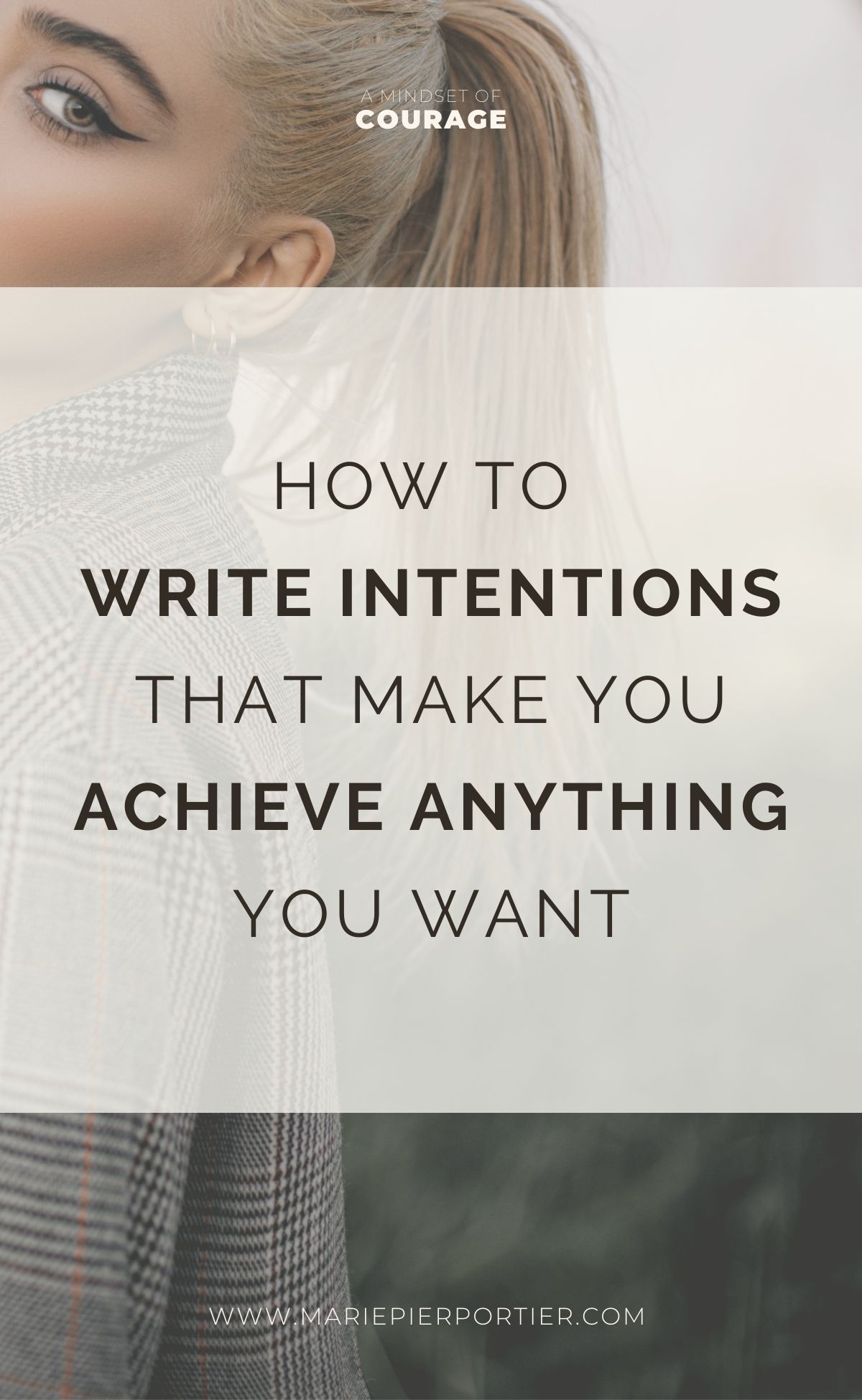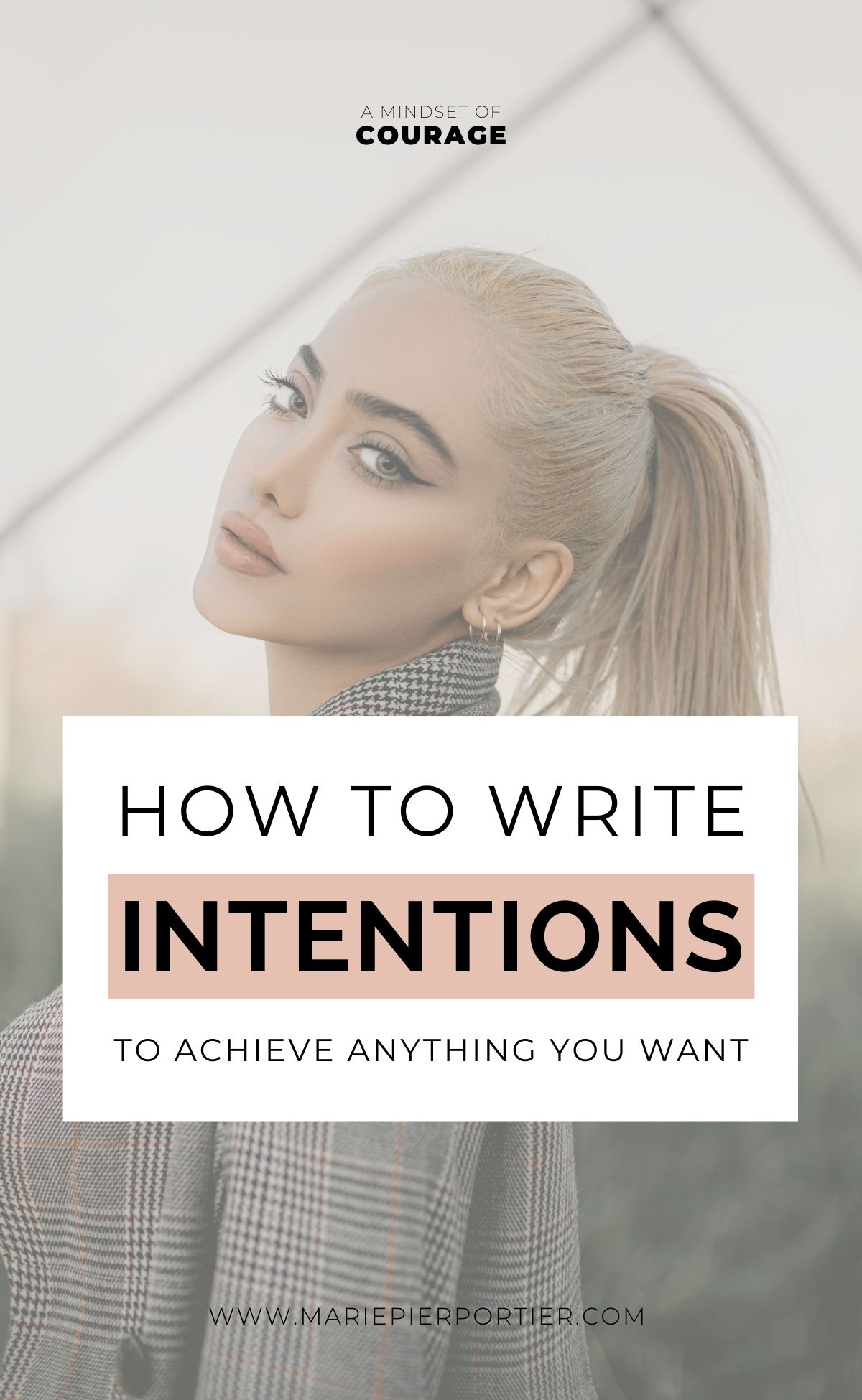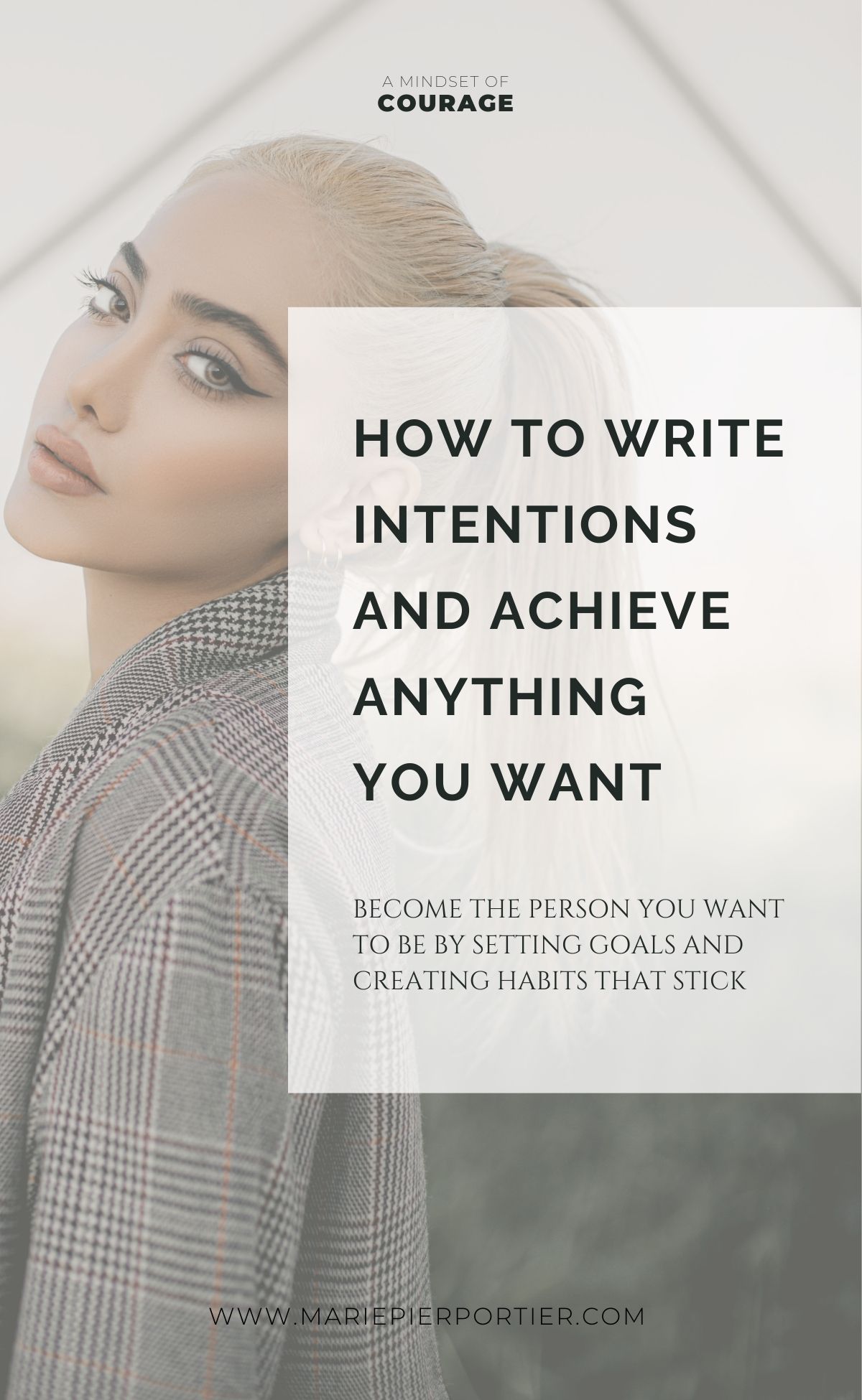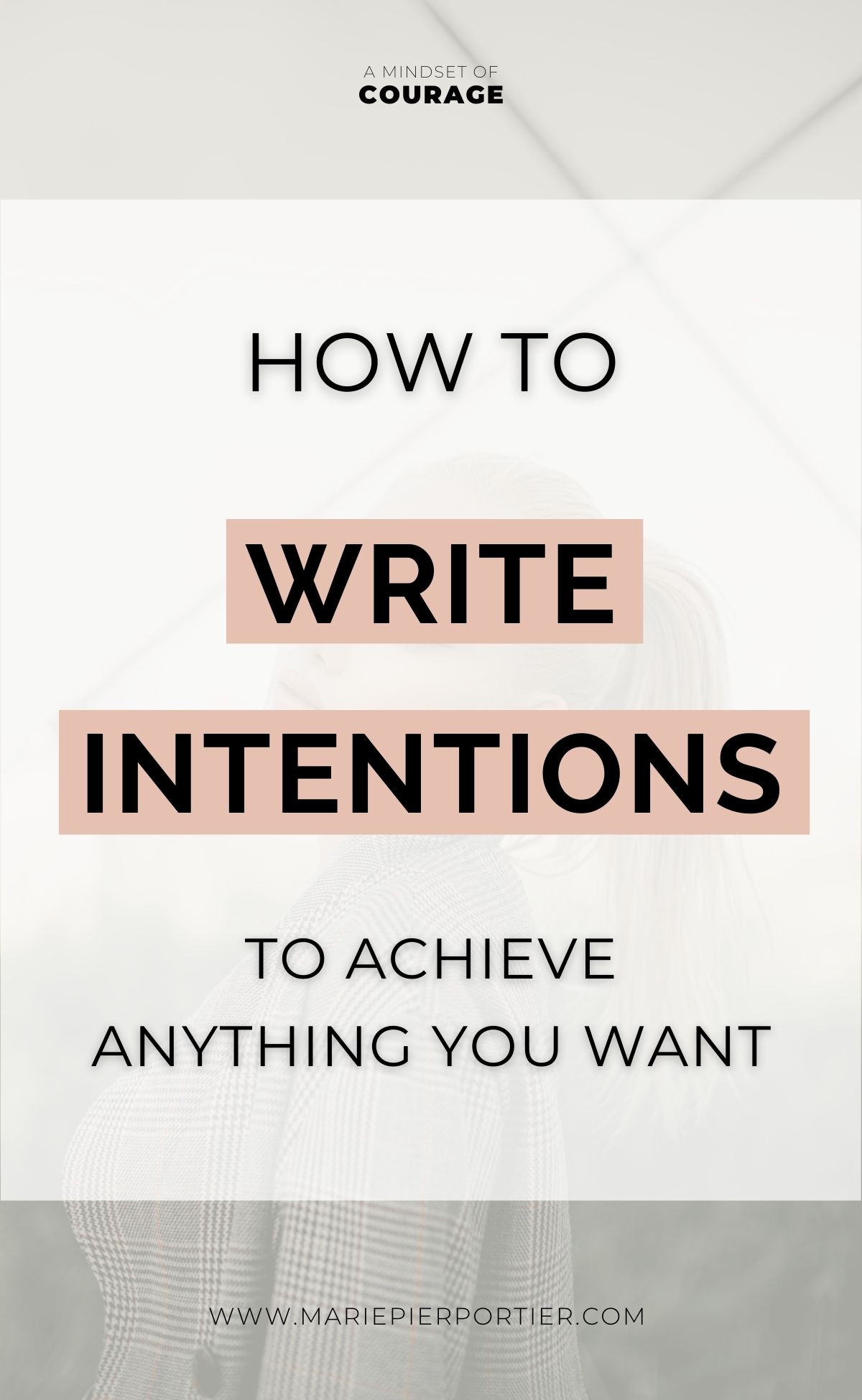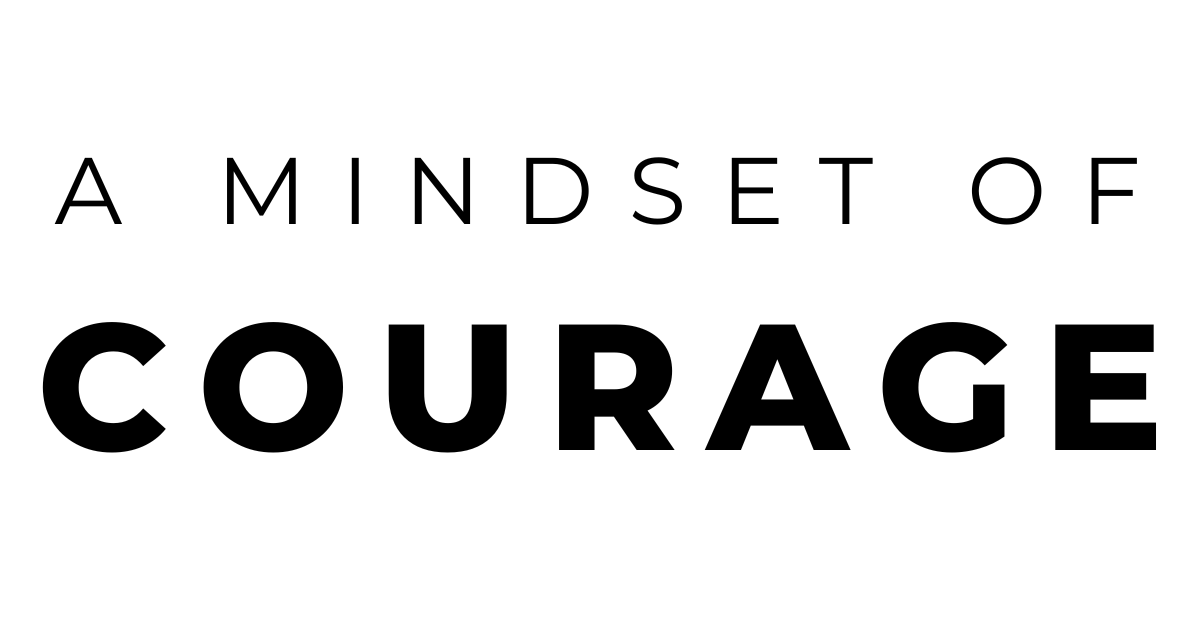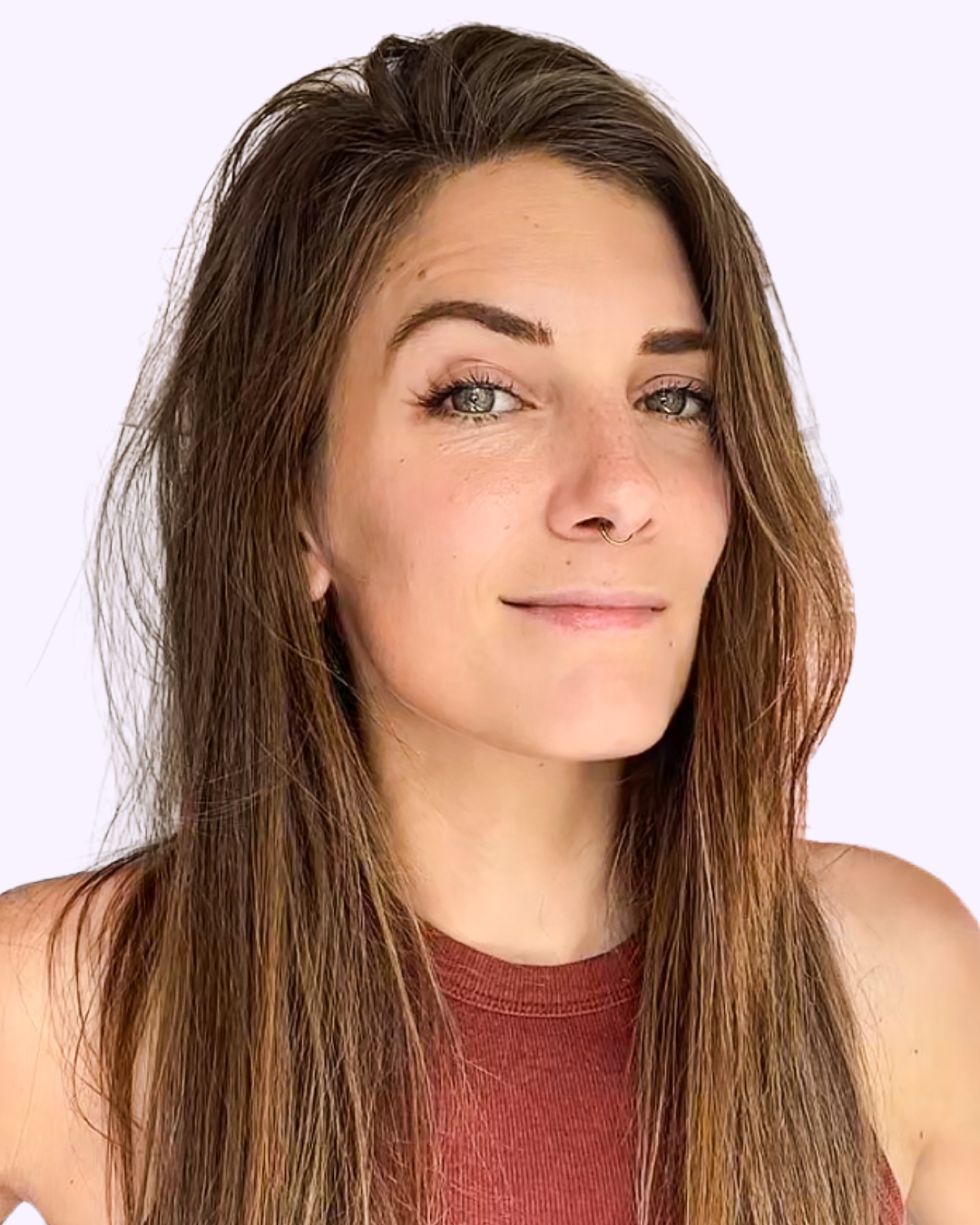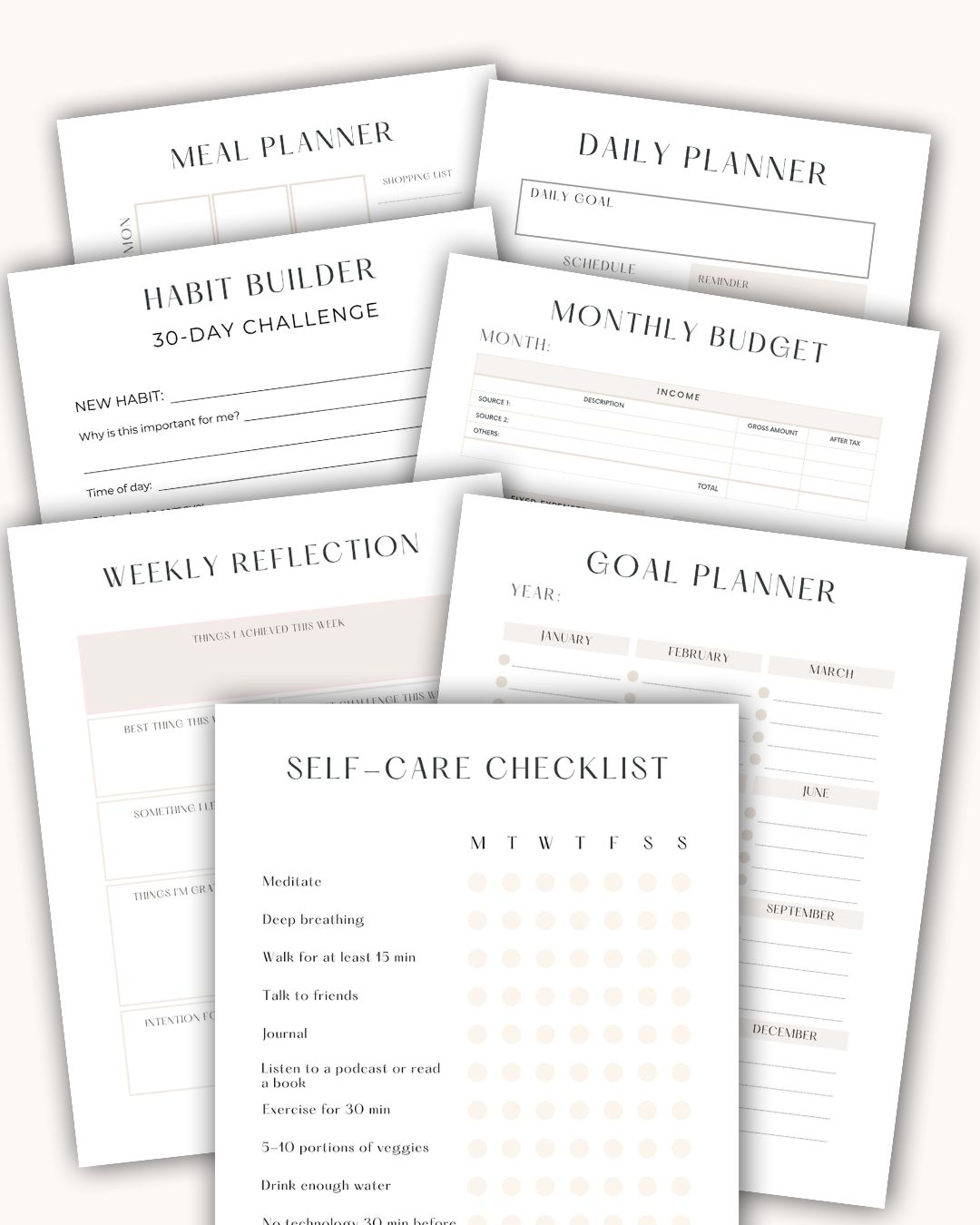Writing intentions is beneficial for keeping track of our goals. Okay. But how the heck do we write intentions? I’m going to walk you through the whole step by step process. Learn how to write intentions that really help achieving your goals.
This post contains affiliate links which means that if you click and make a purchase I might get a commission, without extra cost for you. Read full disclosure here.
Why learning how to write intentions is important for success
To be intentional with your actions, you need to know what you’re trying to accomplish.
In this post, I’m focusing on how to write intentions that make a difference in your life.
I mean intentions that have a positive impact on your future self and that will help you easily work towards your goals.
Writing intentions helps make the best choices for becoming the person we want to be. But first, we need to know who that person is.
I’m going to break down the step by step process to write intentions by first help you define your vision of the person you want to become. Then, you’ll set goals to make this vision come to life. Then, I’ll show you how to write intentions based on these goals.
Don’t want to learn the whole process to achieve your goals?
Scroll down directly to STEP 5 on how to write intentions
or
Scroll down to the end of the post for a real life example of the whole process.
How to write intentions focused on habits
A lot of the concepts in this article are taken from the book Atomic Habits, by James Clear. In that book, he breaks down a step by step process based on science to create new habits and get rid of bad ones, for good.
If you’re interested in learning more about creating new habits, I highly recommend you get your hand on that book.
Purchase Atomic Habits on Amazon (click here)
How to write intentions the WRONG way
Writing impactful intentions helps make good habits stick. But it requires to set goals, first.
Most people, when trying to set goals, are only focused on results, or outcomes. If you want to lose weight, you focus on the numbers on the scale. If you want to get fit, you focus on what you see in the mirror.
Then, with outcomes in mind, you take action. If you want to get fit, you start to exercise. The problem is that habits have a really poor chance to stick when the focus is on outcomes.
Thats’s because actually seeing the outcomes takes time. We don’t usually get an instant reward from the effort we make.
So people give up, thinking the pain they’re going through is not worth the results – results they can’t even see in the early stage of the process.
But here’s a very known principle:
Big transformation is a result of the compound effect of small actions.
Actions have to be consistent to result in a compound effect. And a small action itself don’t produce transformation, therefore don’t give instant gratification.
Therefore, reaching a big goal requires to create habits that work for you.
Intentions or motivation?
When failing to reach a goal, the problem is not lack of motivation. The problem is the strategy people use to create the habit around that goal.
The typical way to build a habit – the one that fails –, is to set a desired outcome first, then to create a routine, or process, to reach that outcome. But there’s a missing part: you need to be clear on why that goal is important to you.
To create a lasting habit, as James Clear explains very well in his book Atomic Habits, you need to shift your focus from the result you want to achieve to the IDENTITY you’re trying to embody by creating this habit.
Now, here’s why this matters when we learn how to write intentions:
- We set goals to get closer to the person we want to be (identity).
- We need to create habits (processes) to reach these goals.
- We write intentions to help us stick to our habits.
In other words, sticking to our habits will make us reach our goals, and reaching our goals will help us become the person we want to be.
How to write intentions to achieve everything you want
Now, let’s break it down into a step by step process: how to write intentions to create habits; to reach your goals; to become the person you want to be.
*There is a real life, step by step example of the whole process at the end of the post.
- Define your ideal self
- Set goals according to your ideal self
- Create habits around your goals
- Set boundaries to stick to your habits
- Write intentions to respect your boundaries
Save on Pinterest for later
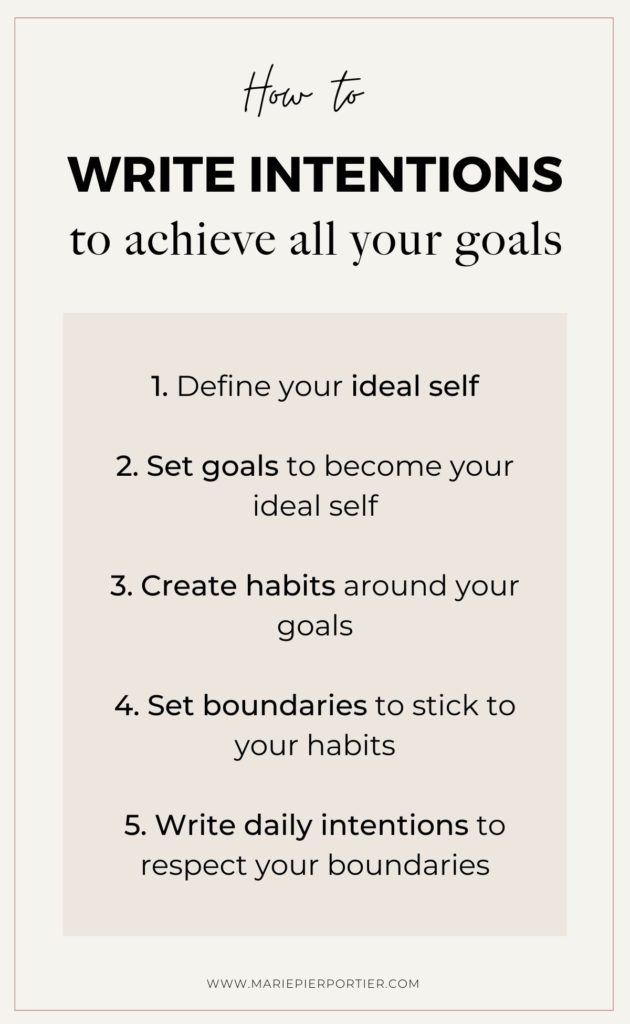
STEP 1: DEFINE YOUR IDEAL SELF
Who’s the person you want to become to live your most authentic, meaningful and happy life?
In your journal, take your time to answer these 2 questions*:
- How do you describe your ideal self?
- What is your definition of success?
for each area of your life:
- health & self care
- personal growth
- relationships (love, family & friends)
- home & lifestyle
- work, career & money
*There’s a real life example of this process at the end of the post.
Never wrote in a journal before? This post will help you get started:
> Journal Prompts for Beginners: How to Write in a Journal
Why defining your ideal self matters to write intentions
Whether we’re aware or not, every decision we make is guided with how we define ourselves. We choose an identity and we embody it through our actions.
In our mind, we have a definition of that identity. We have beliefs around the “right” definition of that identity.
We then take actions to match that definition. Those actions translate how we think a person with that identity should behave.
Here’s a real life example of taking action to match a definition based on beliefs:
If you define yourself as a selfless person (identity), you will try and behave in a way you consider selfless. But what’s your definition of selfless? If you believe that being selfless translates to never say no (action that match your belief), you will try and never say no.
So, when you say no, you might feel very triggered (most likely guilty). That’s because saying no goes against your definition of selfless. Saying no challenges your identity as a selfless person. It feels inauthentic.
Struggling to say no? These articles might help:
> How to Say No with Confidence and Freedom from Guilt
> 10 Affirmations to Express Boundaries Without Guilt
So, what is your ideal self like? How do they behave?
To read more on defining your identity or ideal self, I recommend reading that book details how to define the different roles you have in your life:
> The 5 choices – The Path to Extraordinary Productivity (click here to buy on Amazon).
STEP 2: SET GOALS
What do you want to achieve to become your ideal self?
With your ideal self in mind, set realistic goals* for each area you want to improve:
- health & self care
- personal growth
- relationships (love, family & friends)
- home & lifestyle
- work, career & money
*There’s a real life example of this process at the end of the post.
When it comes to setting measurable goals, don’t forget to always refer to your ideal self and what’s your definition of success of them.
You can set goals for every area of your life for which you defined your ideal self. And to set goals, look back at your definition of success for each are of your life.
Goals should be specific and, most importantly, measurable.
Here’s an example of non specific, non measurable goals:
- Become fit
- Lose weight
You also want to be able to track your progress. So when you set a goal, ask yourself: what metrics, or numbers, matter when it comes to that goal? What are you going to measure?
Finally, set a timeline. Is it going to be a yearly, monthly or quarterly goal?
Why setting goals matters to write intentions
Before writing intentions, which translates to taking actions, you need to decide what you want to achieve with your actions.
To set goals, you need to be clear on the person you want to become. We set goals to get closer to the person we want to be – our ideal self (step 1).
STEP 3: CREATE HABITS
What habits do I need to create to achieve my goals?
Once you’ve decided what habits you need to create, here’s how to set yourself up to make your habits actually stick.
*There’s a real life example of this process at the end of the post.
1. Write down a plan
Plan EXACTLY when and where you’re going to execute the action.
If you want to do it daily, write down either the time you’re going to do it, or associate it with another habit you already have, such as brushing your teeth and plan to do it right after (or before).
2. Get rid of the obstacles that could make you fail
Make your environment work you.
Set your environment up to make it easy for you to execute your new habit.
When it comes to setting up your environment, get rid of the obstacles that will come up when the time comes to execute the action. All of them.
What could keep you from being consistent on that habit? What could make you fail?
For example, you could decide to leave your phone in another room when you’re trying to focus on an important task.
Ask yourself how you can you overcome these obstacles. Be creative. Especially when you’re planning -when motivation is at its highest.
3. Facilitate your success
What small changes can you make around you that will have a big impact on your habits?
Do everything you can to make it a no brainer when it’s time to execute the action.
When set yourself up, motivation is usually at its highest. Which means it’s the best time to think about everything that can facilitate the habit.
What can you do to facilitate the habit you’re trying to create? Is it so set a reminder on your phone? To set a screen time limit on your phone? Maybe it’s putting your work out clothes next to your bed the night before a scheduled workout.
If you struggle to create habits:
Above is a basic strategy to create a habit. But if you struggle to create healthy habits, I highly recommend James Clear’s Atomic Habits. It’s a step by step practical guideline that will walk you through the whole process. Buy Atomic Habits on Amazon (click here)
James Clear is an expert on creating good habits and getting rid of unwanted habits. He’s made a lot of research around that topic and his book Atomic Habits is a simple, practical summary of HOW to do it.
Why creating habits matters to write intentions
What makes a habit fail is not the lack of motivation or bad intentions. It’s usually the negative mindset that come up when it’s time to take action.
When something becomes a habit, you barely think about it anymore – you do it automatically.
Achieving a goal is the result of a compound effect of little actions – habits. These actions usually don’t give an instant reward, which is what makes is hard to be consistent executing them.
What makes writing intentions powerful is exactly knowing what habits we’re trying to reinforce.
STEP 4: SET BOUNDARIES
What would my ideal self NOT do?
Decide what you will NOT do or tolerate to stay focused on your goals.
Write down your boundaries using the first person to make sure you embody this identity.
*There’s a real life example of this process at the end of the post.
Why boundaries matter to write intentions
When we set goals, we focus on what we’re going to do: I’m going to be fit; I’m going to quit smoking; I’m going to lose weight.
Then, we create habits focused on what we’re going to do: I’m going to work 3x a week.
But what about what we’re NOT going to do?
Setting boundaries is a very efficient way to keep yourself accountable for achieving your goals.
For you, being a fit and healthy person might mean to NOT skip a workout. Or to not buy sugary juices. Or to not look at your phone when you are doing important work tasks.
STEP 5: WRITE INTENTIONS
How do I want to show up?
Describe HOW you want to take action, or how you want to show up in your life.
*There’s a real life example of this process at the end of the post.
1. Writing action-oriented intentions
To write intentions oriented on action, you can simply use the boundaries you previously set. Your boundaries become your intentions.
For example, say you really don’t feel like working out. If you wrote down: I will not skip my work out as an intention, you’re a lot more likely to work out.
And that’s how you make decisions to become the person you want to be. A fit person doesn’t skip a workout. Hence, if you identify as a fit person, you won’t skip workouts.
2. Writing mindset-oriented intentions
Write down intentions that refer to a state of mind in which you want to operate.
This has the power to change the way you feel about yourself very quickly. Take a look at what you want to accomplish. Then, decide how your best self would show up in that instance. Write it down at the first person.
For example, if you have an important presentation at work, ideally how do you want to show up? Confident? Convincing? Empathetic?
Reflecting and writing about your mindset will set you with that mindset. Even if you don’t feel like the person you’re describing.
Why learning how to write intentions matters for success
Writing intentions holds you accountable for respecting your boundaries. You’re making a pact with yourself.
When we’ve set goals and decided on the action to take, writing intentions set our mindset up for success.
How to write intentions for New Year’s
Writing intentions can be done daily, weekly, monthly or for the whole year.
On the first week of January, I personally write intentions for the whole year.
First, I journal about what I want my year to look like. Then I decide what I need to focus on to get there. Then, I translate my thoughts into one or two words: these are my intentional words for the whole year. These are words that I want to remember all year long. I used them to keep a mindset that will help me moving forward with my goals.
Steal my yearly intentions setting process here:
> The Best New Year’s Resolutions Journal Prompts
Conclusion: how to write intentions to achieve anything
Learning how to write intentions will reinforce good habits, help achieve your goals and become the person you want to be. So, reverse engineer the process: Who do you want to be? What goals will help you become that person? How can you create habits that will help you achieve your goals? What boundaries do you need to respect? What yearly, monthly, weekly and daily intentions will help you stay focused?
GET YOUR FREE GUIDE
Your personal guide to setting intentions and to finally achieve all your goals (5 easy steps)
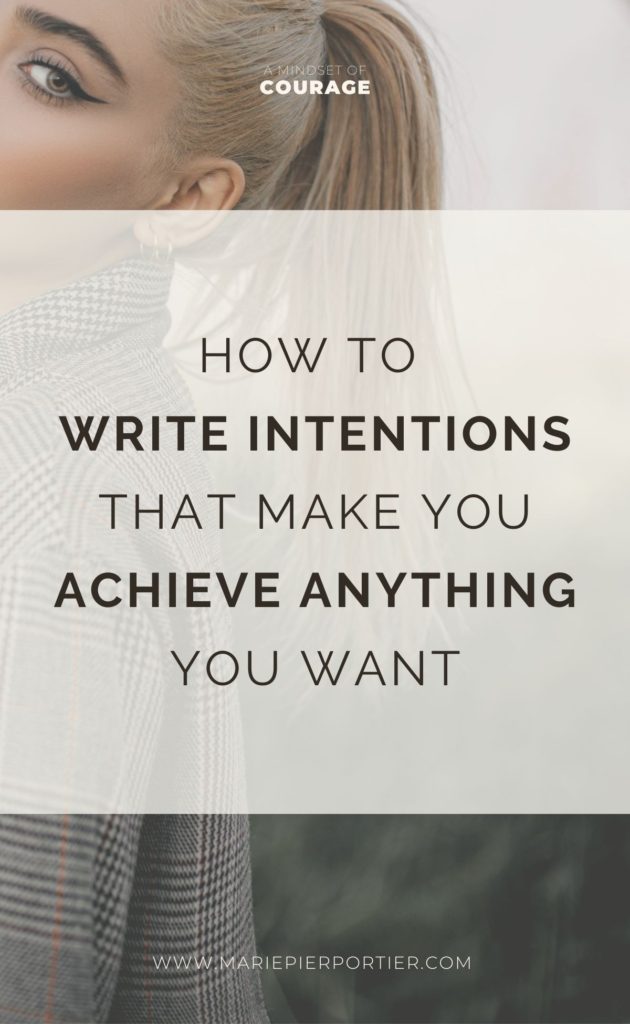
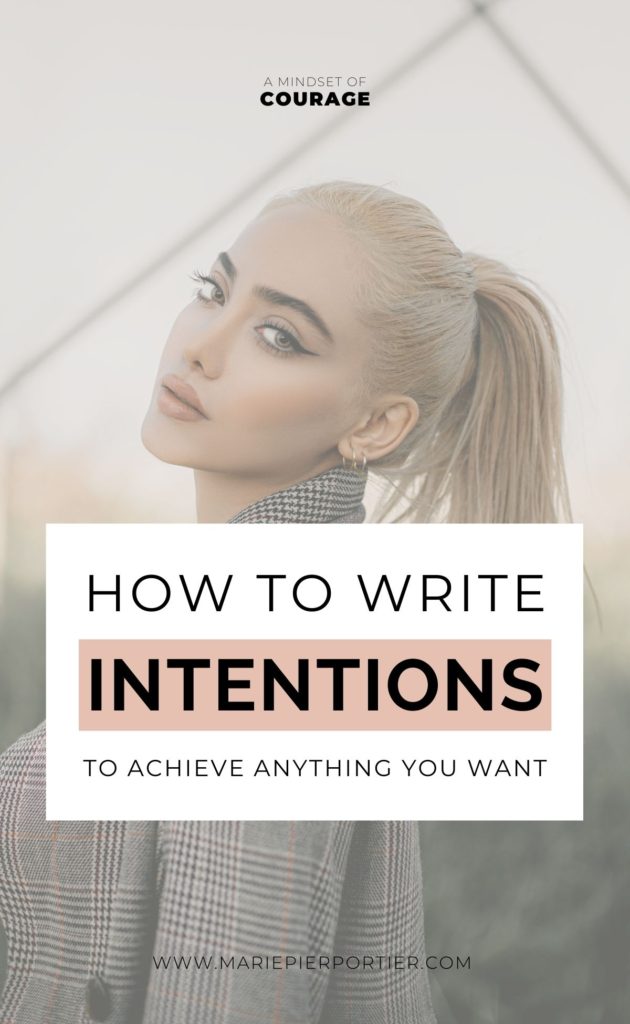
How to write intentions step by step – real life example
Writing intentions to improve physical health
1. Define your ideal self
My ideal self is fit and healthy. I will be successful in being fit and healthy when I will maintain a healthy weight.
2. Set goals
Measurable with a timeline
– Attain a weight of X pounds (or lose X pounds) by the end of the year
3. Create habits
The habit:
Exercise 3x/week
1. Plan
I will exercise every Monday, Wednesday and Friday at 8:00am, before I have breakfast.
2. Get rid of obstacles
Obstacle: Having to go to the gym
Solution: I will set up my living room to be convenient for home workouts.
3. Facilitate
I will get my workout clothes ready by my bed every Sunday, Tuesday and Thursday nights.
4. Set boundaries
I will not skip a workout.
I will not be available for work/friends/family from 8:00am to 8:30 am on Mondays, Wednesdays and Fridays.
5. Write daily intentions
I will finish all my reps, even if it’s hard
When I feel like giving up, I will push myself
